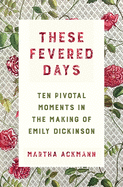
Emily Dickinson wrote 1,789 poems that she hid in a dresser drawer. The majority were published posthumously, catapulting her into history as one of America's best-known and prolific poets. Her poetry is genius in its simplicity and accessibility, both internally focused and observant of the natural world. It is additionally remarkable that Emily Dickinson traveled little, never married and was a famed recluse who preferred to live in her parents' home. While biographies and literary criticism of her poetry abound, in These Fevered Days: Ten Pivotal Moments in the Making of Emily Dickinson, Dickinson scholar and recipient of a Guggenheim fellowship Martha Ackmann (Curveball) adds meticulous detail to the scholarship by placing Dickinson's work in the context of seminal moments in the poet's life.
Ackmann has been surrounded by Dickinson's landscape for years. Living in western Massachusetts (where Dickinson is from) and teaching at Mount Holyoke College (which Dickinson attended when it was the Mount Holyoke Female Seminary), Ackmann is particularly familiar with Dickinson's home, her community and even the views Dickinson would have seen day-to-day. Calling upon her own observations (Ackmann actually wrote sections of the book at Dickinson's desk) and using primary source material, Ackmann centers her work on critical events and influences. These include the monumental, like the Civil War, and the intimate, like the poet's internal struggle between wanting to be distinguished and her hesitancy to publish her poetry. Though at times Ackmann loses the forest for the trees, These Fevered Days will resonate with the many fans Dickinson has accrued since her death. --BrocheAroe Fabian, owner, River Dog Book Co.

